NVIDIA’s GeForce GTX 480 and GTX 470: 6 Months Late, Was It Worth the Wait?
by Ryan Smith on March 26, 2010 7:00 PM EST- Posted in
- GPUs
Compute
Update 3/30/2010: After hearing word after the launch that NVIDIA has artificially capped the GTX 400 series' double precision (FP64) performance, we asked NVIDIA for confirmation. NVIDIA has confirmed it - the GTX 400 series' FP64 performance is capped at 1/8th (12.5%) of its FP32 performance, as opposed to what the hardware natively can do of 1/2 (50%) FP32. This is a market segmentation choice - Tesla of course will not be handicapped in this manner. All of our compute benchmarks are FP32 based, so they remain unaffected by this cap.
Continuing at our look at compute performance, we’re moving on to more generalized compute tasks. GPGPU has long been heralded as the next big thing for GPUs, as in the right hands at the right task they will be much faster than a CPU would be. Fermi in turn is a serious bet on GPGPU/HPC use of the GPU, as a number of architectural tweaks went in to Fermi to get the most out of it as a compute platform. The GTX 480 in turn may be targeted as a gaming product, but it has the capability to be a GPGPU powerhouse when given the right task.
The downside to GPGPU use however is that a great deal of GPGPU applications are specialized number-crunching programs for business use. The consumer side of GPGPU continues to be underrepresented, both due to a lack of obvious, high-profile tasks that would be well-suited for GPGPU use, and due to fragmentation in the marketplace due to competing APIs. OpenCL and DirectCompute will slowly solve the API issue, but there is still the matter of getting consumer orientated GPGPU applications out in the first place.
With the introduction of OpenCL last year, we were hoping by the time Fermi was launched that we would see some suitable consumer applications that would help us evaluate the compute capabilities of both AMD and NVIDIA’s cards. That has yet to come to pass, so at this point we’re basically left with synthetic benchmarks for doing cross-GPU comparisons. With that in mind we’ve run a couple of different things, but the results should be taken with a grain of salt as they don’t represent any single truth about compute performance on NVIDIA or AMD’s cards.
Out of our two OpenCL benchmarks, we’ll start with an OpenCL implementation of an N-Queens solver from PCChen of Beyond3D. This benchmark uses OpenCL to find the number of solutions for the N-Queens problem for a board of a given size, with a time measured in seconds. For this test we use a 17x17 board, and measure the time it takes to generate all of the solutions.
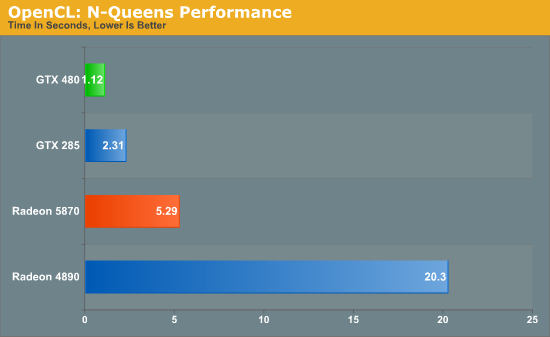
This benchmark offers a distinct advantage to NVIDIA GPUs, with the GTX cards not only beating their AMD counterparts, but the GTX 285 also beating the Radeon 5870. Due to the significant underlying differences of AMD and NVIDIA’s shaders, even with a common API like OpenCL the nature of the algorithm still plays a big part in the performance of the resulting code, so that may be what we’re seeing here. In any case, the GTX 480 is the fastest of the GPUs by far, beating out the GTX 285 by over half the time, and coming in nearly 5 times faster than the Radeon 5870.
Our second OpenCL benchmark is a post-processing benchmark from the GPU Caps Viewer utility. Here a torus is drawn using OpenGL, and then an OpenCL shader is used to apply post-processing to the image. Here we measure the framerate of the process.
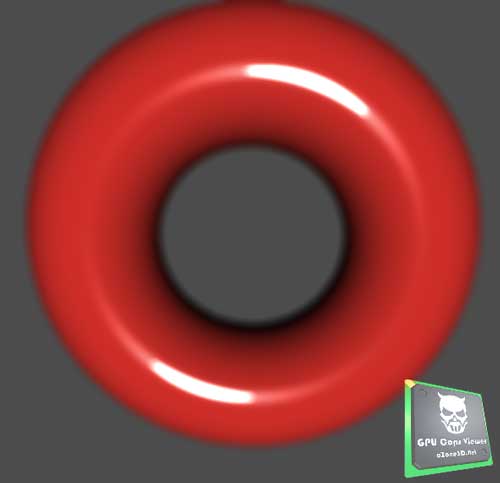
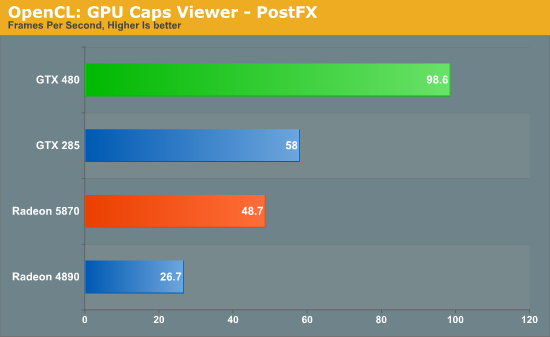
Once again the NVIDIA cards do exceptionally well here. The GTX 480 is the clear winner, while even the GTX 285 beats out both Radeon cards. This could once again be the nature of the algorithm, or it could be that the GeForce cards really are that much better at OpenCL processing. These results are going to be worth keeping in mind as real OpenCL applications eventually start arriving.
Moving on from cross-GPU benchmarks, we turn our attention to CUDA benchmarks. Better established than OpenCL, CUDA has several real GPGPU applications, with the limit being that we can’t bring the Radeons in to the fold here. So we can see how much faster the GTX 480 is over the GTX 285, but not how this compares to AMD’s cards.
We’ll start with Badaboom, Elemental Technologies’ GPU-accelerated video encoder for CUDA. Here we are encoding a 2 minute 1080i clip and measuring the framerate of the encoding process.
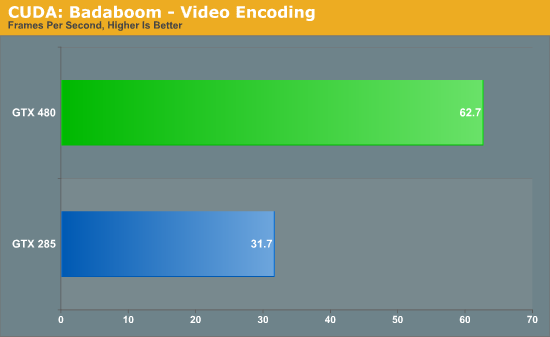
The performance difference with Badaboom is rather straightforward. We have twice the shaders running at similar clockspeeds, and as a result we get twice the performance. The GTX 480 encodes our test clip in a little over half the time it took the GTX 280.
Up next is a special benchmark version of Folding@Home that has added Fermi compatibility. Folding@Home is a Standford research project that simulates protein folding in order to better understand how misfolded proteins lead to diseases. It has been a poster child of GPGPU use, having been made available on GPUs as early as 2006 as a Close-To-Metal application for AMD’s X1K series of GPUs. Here we’re measuring the time it takes to fully process a sample work unit so that we can project how many nodes (units of work) a GPU could complete per day when running Folding@Home.

Folding@Home is the first benchmark we’ve seen that really showcases the compute potential for Fermi. Unlike everything else which has the GTX 480 running twice as fast as the GTX 285, the GTX 480 is a fewtimes faster than the GTX 285 when it comes to folding. Here a GTX 480 would get roughly 3.5x as much work done per day as a GTX 285. And while this is admittedly more of a business/science application than it is a home user application (even if it’s home users running it), it gives us a glance at what Fermi is capable when it comes to compuete.
Last, but not least for our look at compute, we have another tech demo from NVIDIA. This one is called Design Garage, and it’s a ray tracing tech demo that we first saw at CES. Ray tracing has come in to popularity as of late thanks in large part to Intel, who has been pushing the concept both as part of their CPU showcases and as part of their Larrabee project.

In turn, Design Garage is a GPU-powered ray tracing demo, which uses ray tracing to draw and illuminate a variety of cars. If you’ve never seen ray tracing before it looks quite good, but it’s also quite resource intensive. Even with a GTX 480, with the high quality rendering mode we only get a couple of frames per second.
On a competitive note, it’s interesting to see NVIDIA try to go after ray tracing since that has been Intel’s thing. Certainly they don’t want to let Intel run around unchecked in case ray tracing and Larrabee do take off, but at the same time it’s rasterization and not ray tracing that is Intel’s weak spot. At this point in time it wouldn’t necessarily be a good thing for NVIDIA if ray tracing suddenly took off.
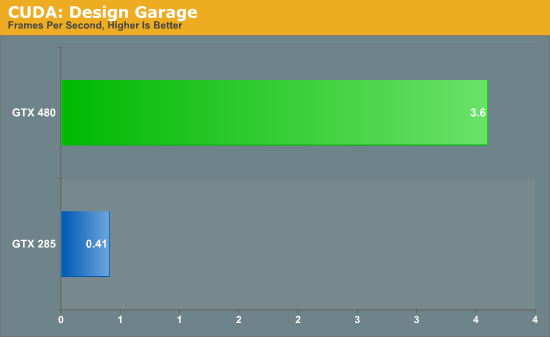
Much like the Folding@Home demo, this is one of the best compute demos for Fermi. Compared to our GTX 285, the GTX 480 is eight times faster at the task. A lot of this comes down to Fermi’s redesigned cache, as ray tracing as a high rate of cache hits which help to avoid hitting up the GPU’s main memory any more than necessary. Programs that benefit from Fermi’s optimizations to cache, concurrency, and fast task switching apparently stand to gain the most in the move from GT200 to Fermi.










196 Comments
View All Comments
arjunp2085 - Friday, March 26, 2010 - link
For dealing with suck fake geometry, Fermi has several new tricks.is that supposed to be such??
850 Watts for SLI.. man Air Conditioning for my room does not consume that much electricity
Might have to go for industrial connections to use such high Electricity consumptions lol
Green Team NOT GREEN....
Leyawiin - Friday, March 26, 2010 - link
Guess I'll keep my GTX 260 for a year or so more and hope for better days.hangfirew8 - Friday, March 26, 2010 - link
Launch FAIL.All this waiting and a paper launch. They couldn't even manage the 1/2 dozen cards per vendor at Newegg of some previous soft launches.
All this waiting an a small incremental increase over existing card performance. High power draw and temps. High prices, at least they had the sense not to price it like the 8800Ultra-which was a game changer. It had a big leap in performance plus brought us a new DX level, DX10.
I've been holding off buying until this launch, I really wanted nVidia to pull something off here. Oh, well.
softdrinkviking - Friday, March 26, 2010 - link
so by the time a "full" gf100 is available, how close will we be the the next gen AMD card?and how low will be the prices on the 58XX series be?
this article never made an explicit buying recommendation, but how many people out there are still waiting to buy a gf100?
6 months is a long time.
after xmas and the post holiday season, anybody on the fence about it (i.e. not loyal nvidia fans) probably just went for amd card.
so the question (for a majority of potential buyers?) isn't "which card do i buy?", it's "do i need/want to upgrade from my 58xx amd card to a gf100?"
also, i'm curious to find out if fermi can be scaled down into a low profile card and offer superior performance in a form factor that relies so heavily on low temps and low power consumption.
the htpc market is a big money maker, and a bad showing for nvidia there could really hurt them.
maybe they won't even try?
shin0bi272 - Friday, March 26, 2010 - link
great review as usual here at Anandtech. I would have thought in your conclusions you would have mentioned that, in light of the rather lack luster 5% performance crown that they now hold, that it wasnt the best idea for them to disable 6% of their cores on the thing after all.Why make a 512 core gpu then disable 32 of them and end up with poorer performance when youre already 6 months behind the competition, sucking up more juice, have higher temps and fan noise, and a higher price tag? That's like making the bugatti veyron and then disabling 2 of its 16 cylinders!
That will probably be what nvidia does when amd releases their super cypress to beat the 480. They'll release the 485 with all 512 cores and better i/o for the ram.
blyndy - Saturday, March 27, 2010 - link
"Fermi is arranged as 16 clusters of 32 shaders, and given that it is turning off 64 shaders, it looks like the minimum granularity it can fuse off is a single cluster of 32. This means it is having problems getting less than two unrecoverable errors per die, not a good sign."from: http://www.semiaccurate.com/2009/12/21/nvidia-cast...">http://www.semiaccurate.com/2009/12/21/nvidia-cast...
shin0bi272 - Saturday, March 27, 2010 - link
dont quote semi accurate to me. If you wanna call 1 in 100 claims being correct as Semi accurate then fine you can... me I call it a smear. Especially since the guy who wrote that article is a known liar and hack. If you google for gtx480 and click on the news results and click on semi accurate you will see its listed as satire.Jamahl - Friday, March 26, 2010 - link
the same Ryan Smith who panned the 5830 for being a "paper launch" even though it was available one day later?What's wrong this time Ryan? Maybe there are so many bad things to say about Fermi, being "paper launched" was well down the pecking order of complaints?
AnandThenMan - Friday, March 26, 2010 - link
I was thinking the same thing. The 5830 got slammed for being a paper launch even though it wasn't, but Fermi gets a pass? Why? This isn't even a launch at all despite what Nvidia says. Actual cards will be available in what, 17 days? That's assuming the date doesn't change again.jeffrey - Saturday, March 27, 2010 - link
I'll third that notion.Even though Ryan Smith mentioned that Fermi was paper launched today, the tone and way that the article read was much harsher on AMD/ATI. That is ridiculous considering that Ryan had to eat his own words with an "Update" on the 5830's availability.
To be tougher on AMD/ATI, when they did in fact launch the 5830 that day and have hard-launched, to the best of their ability, the entire 5XX0 stack gives an impression of bias.
A paper launch with availability at least two and a half weeks out for a product six months late is absurd!